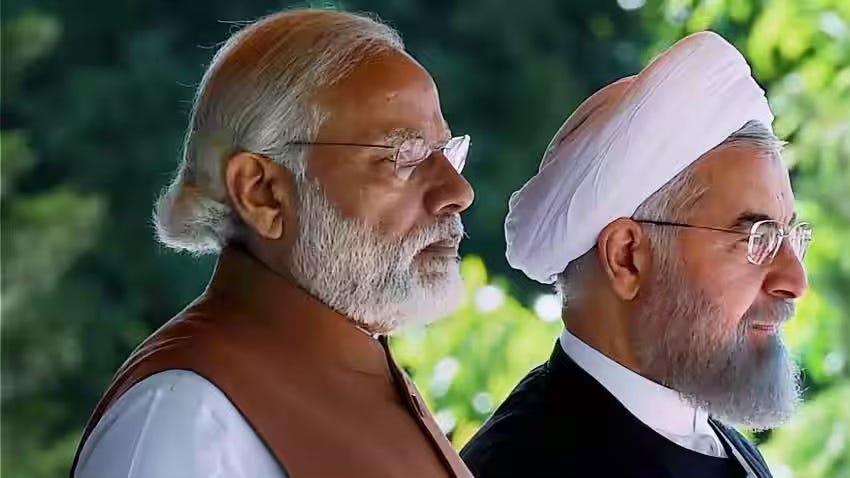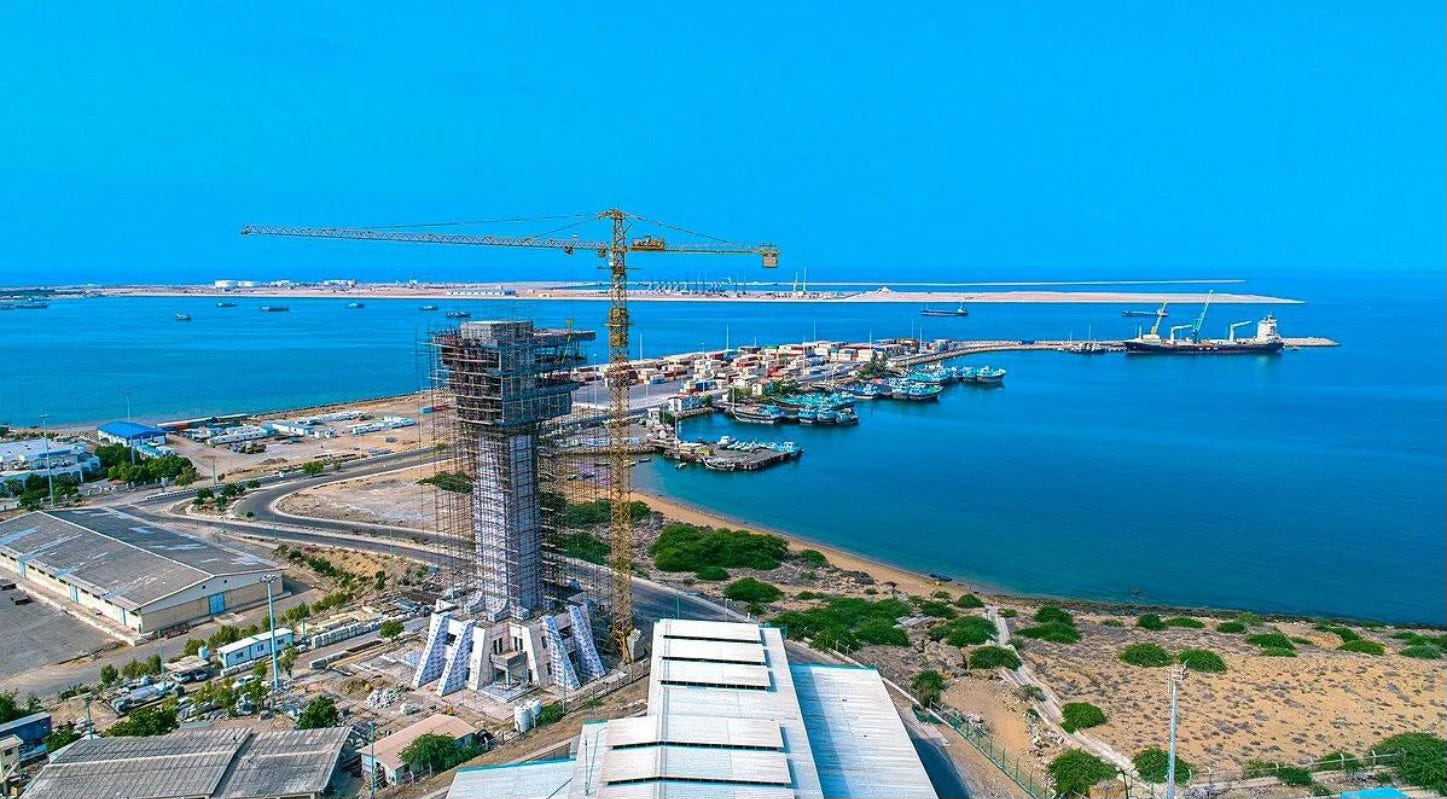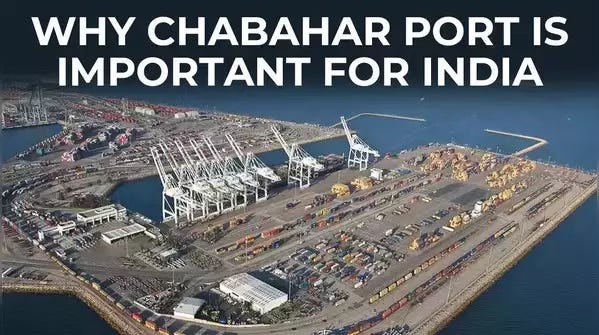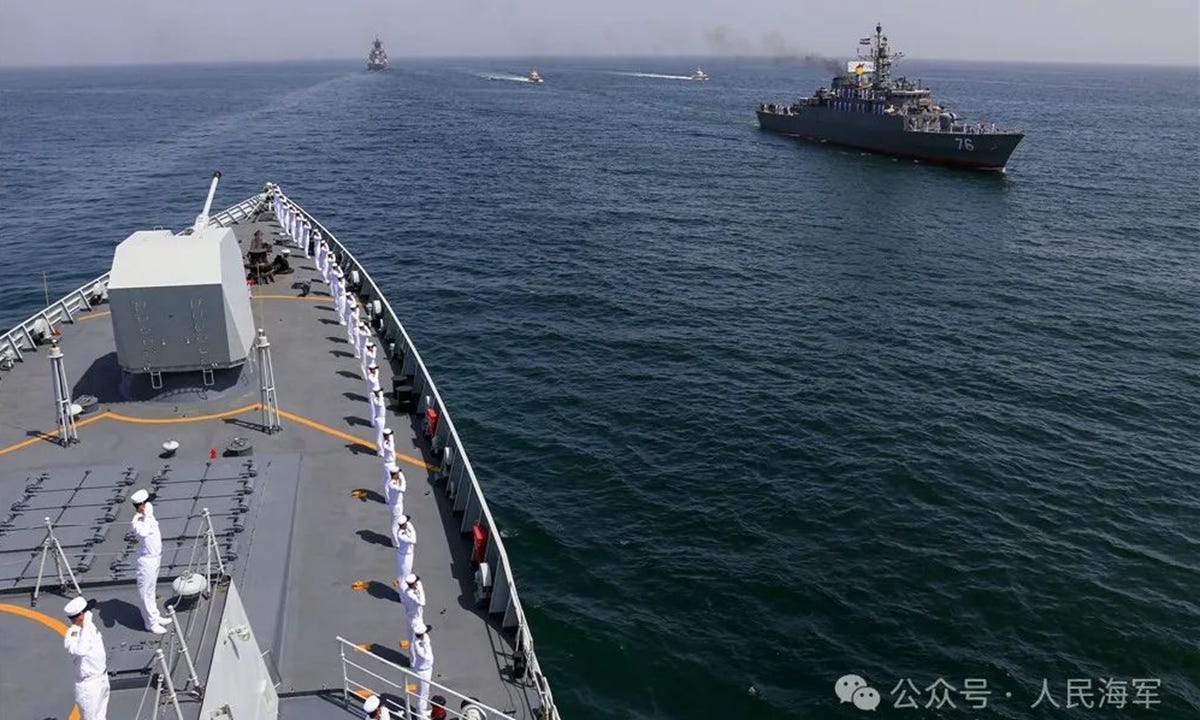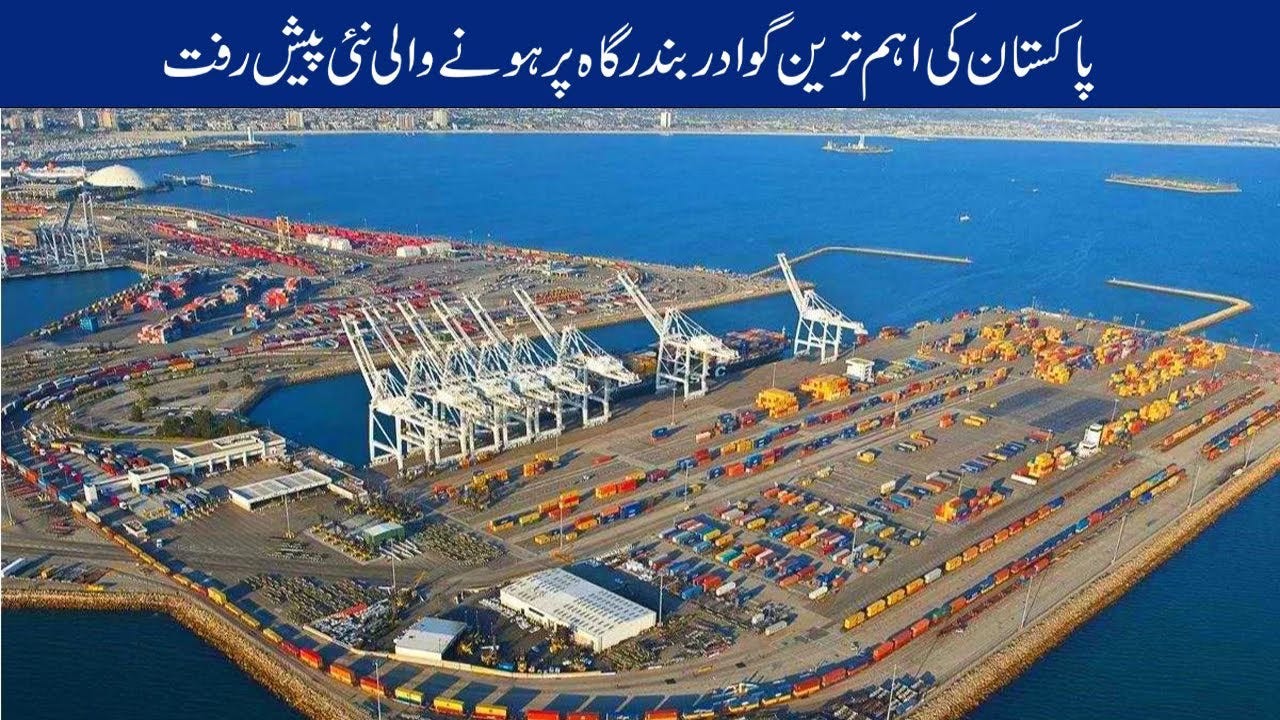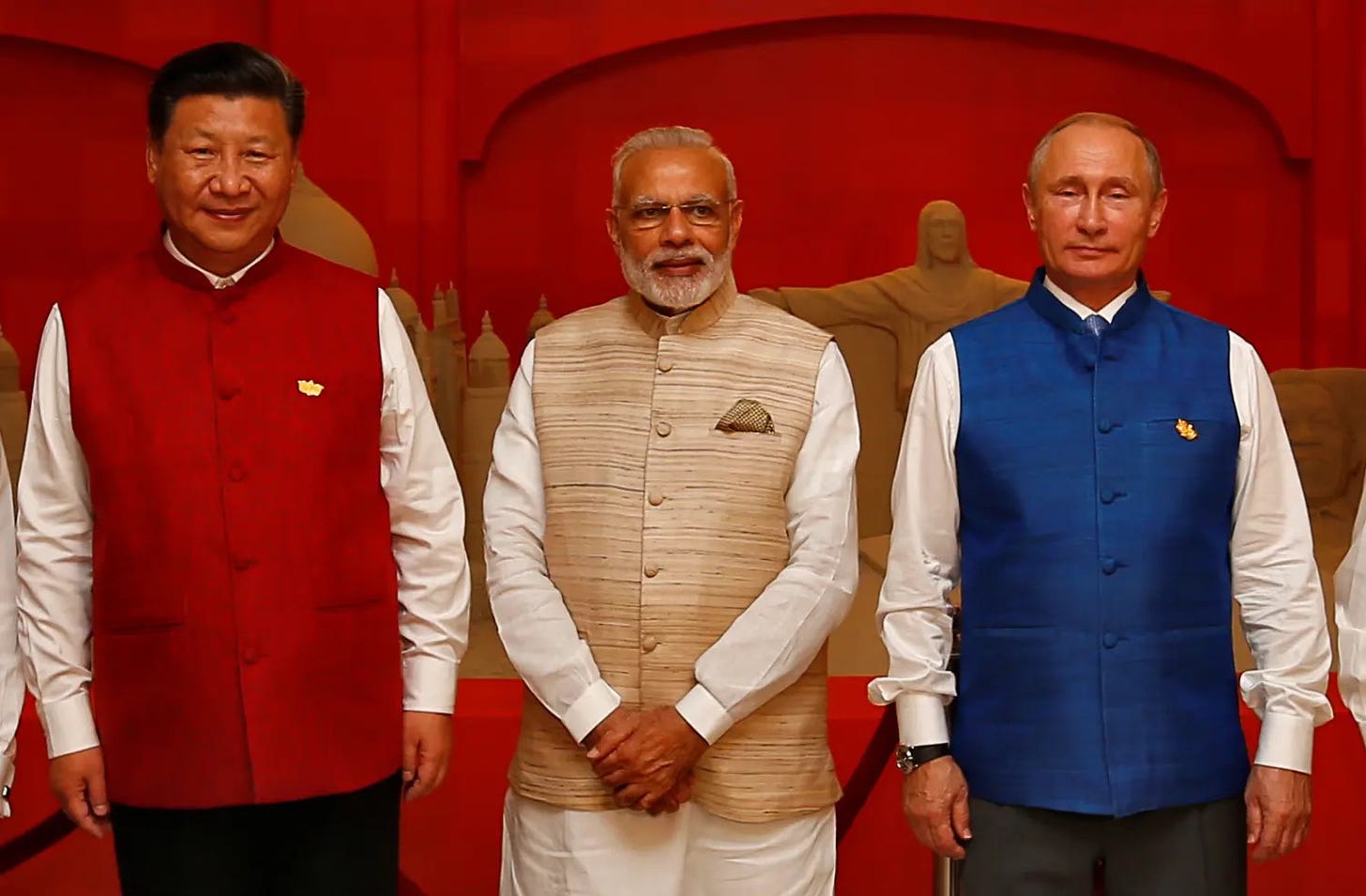Port Authority
India operates Chabahar Port, US threatens new sanctions, Why Chabahar is important, China, Iran, Russia joint naval exercise in Gulf of Oman, 2016 US Sanctions slowed Development, Chabahar vs Gwadar.
India to Operate Iran's Chabahar Port
India and Iran have inked a deal allowing India Ports Global (IPGL) company to develop and control the management of an Iranian port for 10 years.
According to the deal, signed on Monday, IPGL is allowed to manage the transit operation of Indian goods to Afghanistan and Central Asia at the port in Chabahar, on Iran's southeastern coast along the Gulf of Oman.
Sarbananda Sonowal, India's Minister of Ports and Shipping, visited Iran today to participate in the ceremony and discuss boosting relations.
Since 2016, IPGL has invested $85 million in Chabahar to develop the Iranian port, aiming to create a rival to the Chinese-funded Pakistani Gwadar and Karachi ports – and to expand trade with Central Asia and Afghanistan.
The Indian company was supposed to have invested $250 million in Chabahar by now, but the investment has been delayed due to financial obstacles and Iran's procrastination in developing the Chabahar-Zahedan railway.
This railway is crucial for connecting the port to the national railway network and facilitating the transit of Indian goods to target markets.
Under the new agreement, the investment value is expected to reach $370 million. This project obtained a US sanctions waiver in 2018.
"As and when a long-term arrangement is concluded, it will clear the pathway for bigger investments to be made in the port," Indian Foreign Minister Subrahmanyam Jaishankar told reporters in Mumbai.
The Strategic Significance of Chabahar Port
Indian trade with Central Asia and Afghanistan remained unchanged at $2 billion during last year due to its dependence on Chinese and Pakistani territory to connect the target markets.
For comparison, Indian trade rival China had $90 billion trade turnover with Central Asian states, including Kazakhstan, Uzbekistan, Kyrgyzstan, Turkmenistan and Tajikistan in 2023 – which increased by 27% year-on-year, China Customs statistics indicate.
China also had $1.33 billion trade with Afghanistan last year, 40% more than India’s.
According to the International Monetary Fund, Central Asian states had $143 billion export and $95 billion import with foreign countries.
The Indian Commerce Ministry’s statistics show the mentioned states share only 0.5% of India’s total foreign trade.
India, Iran and Russia also signed a transit agreement in 2000, but neither India nor Russia transits good through Iranian territory due to its poor logistic infrastructures.
In terms of the logistics performance index (LPI), the World Bank has ranked Iran among the poorest countries.
Last year, the Islamic Republic ranked 123 of the 139 countries compared, marking the lowest score among all neighbors, except Afghanistan. Even Iraq outperformed Iran in terms of LPI, ranking 115 globally.
Given the current circumstances, while the transit of Indian goods through Iran to Russia seems unlikely, the Chabahar port holds significant potential for fostering trade between India and Central Asia or Afghanistan in the years ahead.
Last year, more than 4.2 million tons of goods were loaded or unloaded at Chabahar, sharing 2.2% of Iran’s total foreign trade volume. However, only 15,000 tons of goods were transit cargoes, corresponding to 0.1% of Iran’s total foreign cargo transits in 2023.
Therefore, almost all of the loaded or unloaded cargoes at Chabahar was related to Iran and India’s own trade.
India increased exports to Iran by 14% year-on-year to $1.66 billion in 2023, while its imports from Iran experienced a 45% growth to $672 million. Before US sanctions, India imported $11.1 billion and exported $2.65 billion goods to Iran in 2017.
Read more here.
US threatens Chabahar port deal
By Meryl Sebastian (BBC News, Kochi)
The US has warned of potential sanctions for any country considering business deals with Iran, hours after India signed a 10-year contract to operate a port with Tehran.
India had entered an agreement to develop the strategically important Chabahar port, close to Iran's border with Pakistan, in 2016. On Monday, it signed a long-term deal with Iran to develop it further.
India's shipping minister called it a "historic moment in India-Iran ties".
But the move may not go down well with the US, which has imposed more than 600 sanctions on Iranian-related entities over the past three years.
In a press briefing on Tuesday, the country's State Department Deputy Spokesperson Vedant Patel said, when asked about the deal, that the US sanctions on Iran are still in place and that Washington would continue to enforce them.
"Any entity, anyone considering business deals with Iran - they need to be aware of the potential risks that they are opening themselves up to and the potential risk of sanctions," he said.
India has not responded to the statement yet.
India took over operations of the port at the end of 2018. The port opened a transit route for Indian goods and products to Afghanistan and Central Asia, avoiding the land route through Pakistan - neighbours India and Pakistan share a tense relationship.
So far, 2.5m tonnes of wheat and 2,000 tonnes of pulses have been shipped from India to Afghanistan through Chabahar port, officials say.
On Monday, India's shipping ministry said that the Indian Ports Global Limited (IPGL) and the Port & Maritime Organisation of Iran signed a long-term deal for the development of the port.
Under the agreement, IPGL will invest about $120 million with an additional $250 million in financing, bringing the contract's value to $370 million, said Iran's Minister of Roads and Urban Development Mehrdad Bazrpash.
India's Foreign Minister S. Jaishankar said the deal "will clear the pathway for bigger investments to be made in the port".
Read more here.
Why is Chabahar is important for India?
By Times of India
The new pact helps counter Pakistan and China
Chabahar port pact explained
India has inked a 10-year agreement to manage the strategically located Iranian port of Chabahar, aimed at facilitating expanded trade with Central Asia. The Chabahar port, situated on the Gulf of Oman and initially proposed for development by New Delhi in 2003, will serve as a crucial gateway for Indian goods to access landlocked Afghanistan and Central Asia. This will be achieved through the implementation of the International North-South Transport Corridor, a road and rail project, thus bypassing Pakistan. The development of Chabahar port by India is widely seen as India’s counter to Pakistan’s Gwadar port and China’s Belt and Road Initiative. Why is the Chabahar port pact significant for India? We take a look:
India's Answer to Pakistan, China
Chabahar port agreement grants India operational control, following its financial investment in the port's expansion. Its timing holds significance amidst the ongoing crisis in West Asia, which has disrupted vital trade routes. This marks India's first instance of managing a port overseas. The port serves as a crucial connectivity link for India to Afghanistan, Central Asia, and the broader Eurasian region, countering Pakistan's Gwadar port and China's Belt and Road Initiative. Positioned as a hub for transit trade between India, Iran, and Afghanistan, it offers an alternative route to the traditional Silk Road through China. With its strategic location near the Strait of Hormuz and the Indian Ocean, the port presents significant potential.
Chabahar Port To Kandla Port Distance
Chabahar port distance from India's ports: The Kandla port in Gujarat stands as the nearest to the Chabahar port, with a distance of 550 nautical miles, while the distance between Chabahar and Mumbai spans 786 nautical miles.
Chabahar port expansion
Plans are underway to integrate Chabahar with the International North South Transport Corridor (INSTC), facilitating a direct route from India to Russia via Iran. This strategic port will allow India to circumvent Pakistan, gaining access to Afghanistan and, subsequently, Central Asia. India and Iran have positioned the port as a pivotal node within the INSTC initiative. The INSTC spans 7,200 kilometers and encompasses various modes of transportation, serving as a comprehensive freight transport project connecting India, Iran, Afghanistan, Armenia, Azerbaijan, Russia, Central Asia, and Europe.
Chabahar port history
In May 2016, India entered into a tripartite agreement with Iran and Afghanistan to foster the development of the Shahid Beheshti Terminal at Chabahar. However, following the Taliban's assumption of power in Afghanistan last year, the country's involvement in the arrangement has been curtailed. India committed to investing $85 million in the terminal and has already supplied cranes and other equipment valued at several million dollars. India persists in operating and outfitting the container and multi-purpose terminals at Chabahar Port in accordance with existing agreements.
Chabahar port agreement details
The progression of the port's development was hindered by US sanctions on Iran due to its suspected nuclear program. On May 13, 2024, a long-term agreement was formalized between Indian Ports Global Limited (IPGL) and the Port & Maritime Organization of Iran. IPGL is set to invest approximately $120 million, with an additional $250 million to be sourced through debt financing. This fresh long-term agreement aims to supersede the initial contract, spanning a duration of 10 years with automatic renewal provisions.
Chabahar port location
Situated in the southeastern province of Sistan-Baluchestan, the Chabahar port presents Iran with a significant opportunity to enhance its economic outlook by welcoming investments from India. This decision has unlocked a plethora of opportunities for Iran, encompassing strengthened economic relations with India, access to Central Asian markets, and the opportunity to diversify its ties with other regional powers. India's offerings include investments in infrastructure development, such as road and rail networks, along with the potential to emerge as a major market for Iranian goods.
Chabahar Port Infrastructure
The Chabahar port agreement was formalised in a ceremony graced by India's Ports, Shipping, and Waterways Minister Sarbananda Sonowal and Iranian Transport and Urban Development Minister Mehrdad Bazrpash in Tehran. Chabahar featured prominently in discussions between Prime Minister Narendra Modi and the Iranian President in 2023, notably during the BRICS summit in South Africa in August and later in November, amid discussions over the Gaza crisis conducted over the phone.
Read more here.
China, Iran, Russia wrap up sea phase of joint naval exercise in Gulf of Oman
By Liu Xuanzun and Guo Yuandan
Rescue training of commercial ships reflects peaceful nature of trilateral cooperation
The naval forces of China, Iran and Russia hold a fleet review during the sea phase of the Security Belt-2024 joint exercise held near the Gulf of Oman from March 12 to 13, 2024. Photo: Screenshot from the WeChat account of the PLA Navy.
The five-day China-Iran-Russia joint naval exercise Security Belt-2024 on Wednesday wrapped up its sea phase. The core part of the drill saw warships from the three countries conducting training to rescue civilian ships, which reflected the peaceful nature of the trilateral cooperation, experts said on Thursday.
Held near the Gulf of Oman from Tuesday to Wednesday, the sea phase of the joint exercise featured training courses including live-fire shooting at maritime targets and armed rescue on hijacked commercial ships, the Chinese People's Liberation Army (PLA) Navy said in a press release on Thursday.
On Tuesday, the three countries' warships took turns and fired at mock targets at sea during both day and night, and practiced light signal communications, the PLA Navy said, attaching a photo showing a Chinese special force member firing a machine gun on board of a warship.
On Wednesday, the three countries mixed their vessels into two task forces and conducted a rescue operation for two Iranian ships playing the roles of commercial ships.
Under the command of the PLA Navy destroyerUrumqi, the task force one consisted of six warships from the Chinese and Iranian sides quickly maneuvered to advantageous positions, conducted reconnaissance on a mock commercial ship hijacked by pirates, and sent small boats to approach the vessel.
Special force members then boarded the ship, neutralised the mock hostile forces, controlled the vessel and rescued the mock hostages.
The exercise also practiced extinguishing fire broke out on the mock commercial ships, another photo released by the PLA Navy shows.
With the participating warships' return to the Chabahar Port in Iran on Wednesday local time, the sea phase of the Security Belt-2024 joint exercise successfully completed, the PLA Navy said.
The joint exercise, kicked off on Monday and will run until Friday, is organised in three phases, namely the harbour phase, the sea phase and the summarise phase, China Central Television (CCTV) reported on Tuesday after the launch of the drills.
The sea phase is usually the core part of a naval exercise that features actual force deployment, while the harbor phase and the summarize phase often include organizing and tactical discussions as well as exchanges that boost participants' mutual understanding and friendship, a Chinese military expert who observed several other joint naval drills told the Global Times on Thursday, requesting anonymity.
Highlighted by the rescue of hijacked commercial ships near the Gulf of Oman, an important international sea lane featuring the transport of key energy and goods, the exercise showed that the trilateral military cooperation focuses on the safeguard of the maritime security in the region in terms of non-traditional security threats, rather than dealing with traditional security threats or stressing bloc confrontation or geopolitics, the expert said.
Zhang Junshe, another Chinese military expert, told the Global Times that the China-Iran-Russia joint exercises, which have been held for four editions since 2019, all focused on non-traditional security threats, and they did not target any third country, nor were they related to regional situations.
The exercise area near the Gulf of Oman, located in the northern part of the Arabian Sea, is connected with the Persian Gulf with the Strait of Hormuz, giving it strategic significance in terms of international shipping, experts said, noting that the trilateral exercise is conducive to the safeguard of the international sea lane as well as maritime security in the region.
Read more here.
US Sanctions Contained Chabahar
By Reuters/AFP
US sanctions on Iran, however, slowed the port’s development.
India signed a 10-year contract with Iran on Monday to develop and operate the Iranian port of Chabahar, the Narendra Modi-led government said, strengthening relations with a strategic Middle Eastern nation.
India has been developing the port in Chabahar on Iran’s south-eastern coast along the Gulf of Oman as a way to transport goods to Iran, Afghanistan and central Asian countries, bypassing the ports of Karachi and Gwadar.
“Chabahar Port’s significance transcends its role as a mere conduit between India and Iran; it serves as a vital trade artery connecting India with Afghanistan and Central Asian Countries,” India’s Shipping Minister Sarbananda Sonowal said in Tehran, after the signing of the agreement.
“This linkage has unlocked new avenues for trade and fortified supply chain resilience across the region.”
“Iran and India are seeking to develop Chabahar port as much as possible, taking into account the interests of the two countries for joint access to regional markets,” the Indian minister said.
This “long-term contract symbolises the enduring trust and effective partnership between India and Iran,” he added.
The long-term deal was signed between Indian Ports Global Limited (IPGL) and the Port & Maritime Organisation of Iran, authorities in both countries said.
Under the agreement, IPGL will invest about $120 million while there will be an additional $250m in financing, bringing the contract’s value to $370m, said Iranian Minister of Roads and Urban Development Mehrdad Bazrpash.
“Chabahar … can act as a focal point in the transit development of the region,” Bazrpash said at the signing ceremony.
“We are pleased with this agreement, and we have full trust in India,” he added.
IPGL first took over operations of the port at the end of 2018 and has since handled container traffic of more than 90,000 TEUs and bulk and general cargo of more than 8.4m tonnes, an Indian government official said.
A total of 2.5m tonnes of wheat and 2,000 tonnes of pulses have been shipped from India to Afghanistan through Chabahar Port, the official added.
“It will clear the pathway for bigger investments to be made in the port,” Indian Foreign Minister S Jaishankar told reporters in Mumbai on Monday.
Read more here.
Chabahar vs Gwadar
S. Mudassir Ali Shah (repost from Dawn, 2015)
Chabahar provides India an easier land-sea route to Afghanistan.
INDIA and Iran concluded a long-awaited port deal in Tehran on Wednesday, lending a big boost to efforts for promoting regional trade. The Chabahar port near the Iranian border with Balochistan reflects Prime Minister Narendra Modi’s keen interest in forging robust trade links with Central Asia, including landlocked Afghanistan.
In 2003, the two sides had agreed to execute the project, bypassing Pakistan, but the venture made slow progress due to Western curbs on Iran over its controversial nuclear programme. The port’s expansion is expected to whittle down transport costs and cut freight time from India to Central Asia and the Persian Gulf.
Chabahar provides India an easier land-sea route to Afghanistan, where it has fostered close security cooperation and economic interests over the years. New Delhi has already spent $100 million on building a 220-kilometre road in the Nimroz province of Afghanistan. The road will be extended to Chabahar.
Afghanistan is expected to sign a tripartite transit trade agreement on using the port as an alternative route, which could jack up bilateral trade to $3 billion from $700-800 million.
The project’s strategic nature is illustrated by its location along the coast from the Chinese-funded Gwadar port in Balochistan. Noting the prospect of sanctions on Iran being lifted or eased, India plans to fast-track the plan.
Modi’s sense of urgency in concluding trade pacts with Iran and other Persian Gulf nations is apparently driven by Chinese President Xi Jinping’s signing of $46bn energy and infrastructure development agreements with Pakistan last month.
During his daylong visit to Tehran, India’s shipping minister inked with his Iranian counterpart Abbas Ahmad Akhoundi a memorandum of understanding on developing the port on the Gulf of Oman. Both sides overruled America’s call for India and other countries not to rush into doing business with Iran. The US has expressed its concern that India is moving too fast and could undermine the sanctions regime.
After a commercial accord is reached on implementing the pact, Indian firms will, according to the Indian government, “lease two existing berths at the port and operationalise them as container and multi-purpose cargo terminals”, providing Afghanistan with access to the sea and reducing its substantial reliance on Pakistan.
The signing ceremony came on the heels of a warning from the US ambassador to India, who said countries engaging with Iran must wait for the outcome of Tehran’s discussions with the P5+1 group — the US, Russia, China, France, Britain and Germany.
With the next round of talks scheduled for May 12 at Geneva, the European Union and the rest of the partners will join the negotiations three days later. As the negotiators seek to wrap up the process by June 30, there is cautious optimism of a breakthrough.
For its part, the Modi administration insists the development of the port in no way violates sanctions and that it is not bound to enforce Washington’s decisions. The port will enable Iran to open up to the Western world once the sanctions are lifted. India had also expressed its interest in developing a key oilfield, but Iran refused to give it gas marketing rights.
During the government of ex-premier Atal Behari Vajpayee, India slashed oil imports from Iran, a move that left the two countries running into rough weather. The situation worsened in 2014 when Iran hiked import duty on Indian rice from 10pc to 45pc, worrying traders and farmers from Punjab, Haryana and UP.
While eyeing a larger role in Western Asia, Delhi’s regional diplomatic status will see a huge surge with the development of the port. Iran, meanwhile, wants India to help create a free trade zone near Chabahar, some 70km from Gwadar where the Chinese Overseas Ports Holding Company has agreed to help Pakistan establish a free economic zone.
Islamabad’s constant refusal to provide a land route for Indian shipments to Afghanistan via Wagah has frustrated Delhi’s efforts to engage with Kabul economically and strategically. India has pledged $100m for laying railway lines connecting Afghanistan with Central Asia.
In order to ensure the launch of trade activities at Chabahar, India may enter into discussions with the US for seeking a sanctions waiver. Once the nuclear deal is sealed, New Delhi will invest $85m in the purchase of equipment to set up and run a container terminal and a multi-purpose berth at the port, whose operation is estimated to cost India $22.95m annually.
Officially designated as a free trade and industrial zone by the Iranian government, Chabahar has acquired increased significance in terms of an international trade hub. Poised to connect business growth centres in South Asia, the Middle East and Afghanistan, the free trade area is being connected to Iran’s main rail network.
Read more here.



